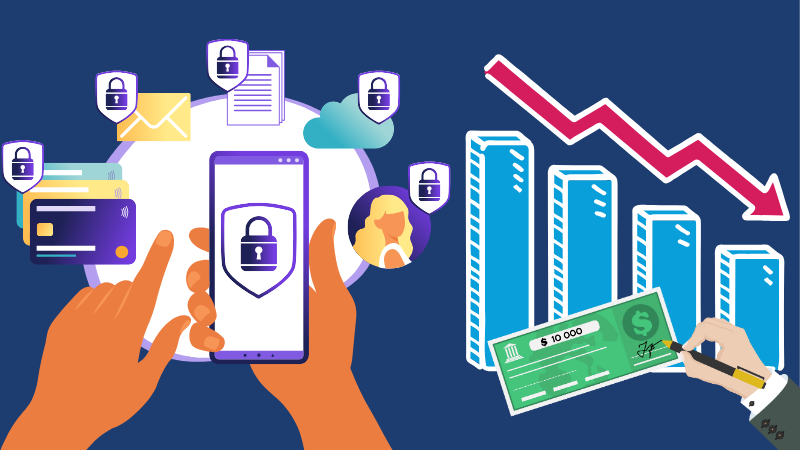
The way we handle financial transactions is undergoing a significant transformation. Traditional payment methods, such as paper checks, which once dominated commerce, are now facing a decline.
This shift is due to technological advancements, changing consumer preferences, and a growing emphasis on efficiency and security. As checks gradually fade into the background, a multitude of alternative payment solutions are emerging, offering convenience, speed, and flexibility.
In this article, we explore why the popularity of checks is waning and the alternative payment methods that are gaining momentum in the United States.
The Decline of Checks
For generations, checks served as the only means of transferring funds, paying bills, and conducting business transactions. However, their usage has steadily declined in recent years, with almost half of Americans not writing a check in 2023. Several key factors have contributed to this downward trend:
Digital Transformation: The advent of online banking, electronic payment platforms, and mobile banking apps has revolutionized how we manage our finances. These digital tools offer unprecedented convenience, allowing users to transfer money, pay bills, and make purchases with just a few taps on their smartphones or clicks of a mouse. In comparison, the process of writing, mailing, and processing paper checks seems cumbersome and outdated.
Cost and Inefficiency: Processing paper checks involves a labor-intensive and time-consuming process, from printing and mailing to depositing and clearing. Businesses incur significant expenses related to printing, postage, and manual processing, making checks less cost-effective than electronic payment methods. Delays in check clearance can disrupt cash flow and slow down financial operations.
Environmental Concerns: As society becomes increasingly environmentally conscious, there is a growing aversion to paper-based transactions. The production and transportation of paper checks contribute to deforestation, carbon emissions, and waste generation. Many individuals and businesses are opting for digital payment alternatives as a more sustainable and eco-friendly option.
Security Risks: Paper checks are susceptible to fraud, theft, and forgery, posing significant risks to both consumers and businesses. Check fraud remains a prevalent issue, with criminals exploiting vulnerabilities in the paper-based payment system to commit identity theft, counterfeit checks, and other fraudulent activities. In contrast, digital payment methods offer advanced security features, such as encryption, multi-factor authentication, and real-time fraud monitoring, enhancing the overall safety of transactions.
Generational Shift: The preferences and behaviors of consumers are evolving, particularly among those who have grown up in the digital age. The younger generations are accustomed to technology and digital lifestyles, and are less inclined to use traditional payment methods like checks. Instead, they prefer the convenience, speed, and flexibility offered by digital wallets, mobile payment apps, and other innovative solutions.
6 Alternative Payment Methods on the Rise
As checks decline in popularity, a diverse array of alternative payment solutions are gaining traction across the United States. These emerging payment methods offer a range of benefits, including convenience, security, and efficiency. Here are 6 of the most prominent alternatives:
1. Mobile Wallets: Mobile payment apps, such as Apple Pay, Google Pay, and Samsung Pay, enable users to store their credit/debit card information securely on their smartphones. With just a tap or scan, users can make contactless payments at compatible terminals, online retailers, and within apps, eliminating the need for physical cards or cash.
2. Peer-to-Peer (P2P) Payment Apps: P2P payment platforms, like Venmo, PayPal, Cash App, and Zelle, facilitate instant money transfers between individuals, friends, family members, and businesses. These apps offer seamless integration with social networks, messaging platforms, and contact lists, making it easy to split bills, share expenses, and send money with just a few taps.
3. Contactless Cards: Contactless payment cards, equipped with near-field communication (NFC) technology, allow users to make secure and swift transactions by simply tapping their cards on payment terminals. Contactless cards offer the same level of security as traditional chip cards but with added convenience and speed, particularly in environments where speed and efficiency are important.
4. Digital Wallets: Digital wallet services, such as PayPal, Amazon Pay, and Visa Checkout, let users store their payment information securely in a digital format. These wallets streamline the checkout process for online purchases, eliminating the need to enter credit card details manually. With just a few clicks, users can complete transactions securely and efficiently, enhancing the overall shopping experience.
5. Cryptocurrencies: While still in early stages of adoption, cryptocurrencies like Bitcoin, Ethereum, and Litecoin offer decentralized and secure digital payment solutions. Blockchain technology enables peer-to-peer transactions without the need for intermediaries, providing greater transparency, privacy, and autonomy. Although cryptocurrencies are not yet mainstream, they represent an innovative and disruptive force in the world of finance, with the potential to revolutionize payment systems and redefine the concept of money.
6. Instant Payments: Real-time payment networks, such as Zelle, the RTP network, and Same Day ACH, enable immediate fund transfers between bank accounts. These instant payment solutions offer businesses and consumers a faster, more efficient alternative to traditional payment methods, such as checks and wire transfers. With real-time payments, funds are available for use within seconds, enabling businesses to streamline cash flow, speed up payroll processing, and improve customer satisfaction.
The decline of paper checks in the United States is a reflection of the digital transformation of financial services. As technology continues to evolve and consumer preferences shift, traditional payment methods are giving way to innovative and efficient alternatives. While checks may still have relevance in certain contexts, their role in the modern economy is diminishing. In their place, an array of digital payment solutions are emerging, offering convenience, security, and speed.
Whether it's mobile wallets, peer-to-peer payment apps, contactless cards, digital wallets, cryptocurrencies, or instant payment networks, the future of payments is undeniably digital.

